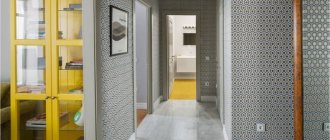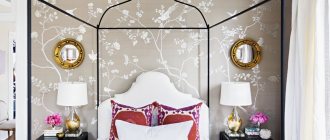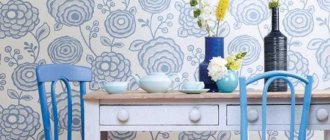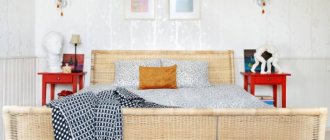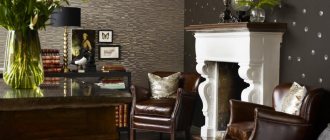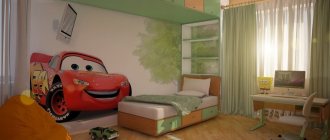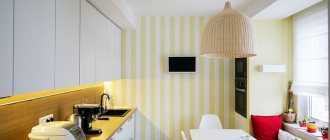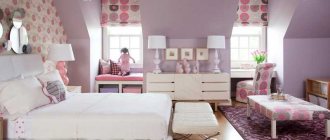A cozy interior necessarily means beautifully decorated walls. To decorate them, you can use paint, panels and other materials, but the most popular option is wallpaper. They play a serious role in the perception of the entire interior as a whole, so it is important to choose their appearance correctly.
In addition, you need to pay attention to performance characteristics. We will discuss all these nuances in detail in the article.
What to consider when choosing quality wallpaper
Of course, the wallpaper should match the style of the interior and look harmonious, but an equally important factor is its quality. Wallpaper from an unscrupulous manufacturer will last you only a short time, so the first thing you need to pay attention to is:
- Environmental friendliness. Wallpaper must be made from safe materials.
- Moisture resistance. This is especially important for the kitchen and children's room.
- Density.
- Easy to care for.
- Resistance to fading and abrasion.
- Fire resistance.
Good wallpaper that meets all of the above criteria may cost more than lower-quality analogues, but in the future you will feel that they are fully worth their cost. They will not have to be re-glued for many years.
Popular options
Today it has become popular to decorate the interior with bright colors.:
- Green and all its shades fit well into any interior style or purpose of rooms, especially in those rooms where people are engaged in mental work.
- Blue and its combinations - the sea and relaxation are associated with it, so blue tones will be good in the bedroom.
- Red wallpaper is a bold decision. When choosing them, remember: too bright colors begin to irritate over time, so it is better to choose more muted shades of red.
But still, classics always remain in fashion. Do you have any doubts that in a couple of years you will get bored with bright walls or go out of fashion? Then it’s better to hang wallpaper in warm colors. They won't become obsolete.
Paper wallpaper
The most common wallpaper. They can have one or two layers. The choice of paper wallpaper is huge: ordinary smooth, with three-dimensional patterns and designs, corrugated. When choosing, pay attention to the weight - the heavier the roll, the better the quality of the wallpaper.
This type of wallpaper is the cheapest, but also the most unreliable.
Bedroom
Any type of wallpaper would be appropriate for the bedroom. But the optimal solution would be wallpaper with silk-screen printing or vinyl coating. Speaking of colors, it is preferable to stick to a pastel palette.
White wallpaper will look great in the bedroom. Blue colors are also a good option. This color will fill the room with freshness and maintain emotional stability.
Green wallpaper was simply created for a bedroom. They have a calming, hypnotic effect. In addition, they calm you down and set you up for a good rest.
Non-woven wallpaper
They combine the advantages of paper and vinyl wallpaper. The composition is 70% cellulose, the rest is connecting materials. Thanks to this, the wallpaper acquires increased density without losing breathability and practicality.
As a rule, the surface of non-woven wallpaper is embossed. If you want to transform the interior, they can be easily repainted several times. Also, such wallpapers initially have an adhesive layer, which simplifies their gluing.
Living room
A variety of types of wallpaper are also suitable for the walls in the living room: textile, silk-screen printing, vinyl. The color palette may vary. There are no strict restrictions here.
Gray wallpaper will fit perfectly into a living room in a high-tech or minimalist style. For a classic interior, wallpaper in warm, natural shades is most suitable. Such a range will visually expand the space and also fill the room with light and air.
- Wallpaper glue - choosing the best composition for different types of wallpaper (60 photos)
Brown wallpaper in a timely interior: 80 photos of wall designs for different rooms
- Red wallpaper - 55 photos of residential interior design using red
An interesting design idea is to use wallpaper in two different tones. Moreover, they can be either contrasting or differ from each other by two or three shades. The photo of wallpaper in two colors shows that such combinations allow you to achieve a very interesting result.
What to look for when choosing wallpaper
The first step is to decide for which room you are choosing wallpaper. Their characteristics must match the room. For example, for a child's room, the best option would be wear-resistant, washable wallpaper. Also consider whether you plan to repaint the walls in the future, or if you're ready to just change the wallpaper.
Pay attention to the symbols on the label and, of course, choose wallpaper that matches the interior.
Design Tips
5 tips for those who are renovating their apartment:
- For a children's room you need to choose delicate pastel colors. It can be soft pink for a girl and blue for a boy.
- For the kitchen, a combination of bright colors and muted colors is optimal. For example, if the cabinets are red, then it is advisable to make the walls plain and discreet.
- The color of the floor in the room should not blend in with the wallpaper (how to choose wallpaper to match laminate flooring?).
- If furniture was purchased first, then the wallpaper will be matched to it. For a luxurious set, it is advisable to choose monochromatic, soothing shades - beige, chocolate, burgundy.
- For light-colored furniture, bright or patterned wallpaper looks better. Otherwise the room will be too faded.
When choosing the coloring and tone of the wallpaper, you need to be guided by the general rules and your wishes. After all, you will live in the house, and all the rooms should please the eye. Therefore, decorate the premises the way you like.
Symbols on wallpaper
Be sure to read the wallpaper label. All information is indicated there: the level of moisture and light resistance, care rules, gluing features. When calculating the number of rolls, you will also have to refer to the markings.
There are the following letter designations that provide information about the type of wallpaper:
- A – acrylic;
- B – paper;
- BB – foamed vinyl;
- PV – flat vinyl;
- RV – embossed vinyl;
- TKS – textile wallpaper;
- STR – structural wallpaper for painting;
- STL – glass wallpaper.
The width and length of the roll can be found on the label. According to the standard, the length is 10 m and the width is 0.53 m or 1.06 m.
Kitchen
It is advisable to choose a warm palette for the kitchen, for example, orange, red, yellow shades. This range will increase the feeling of hunger and give a positive attitude.
For the corridor and hallway it is better to choose dark colors. Moreover, it is necessary to combine the color of the wallpaper with the rest of the walls.
Today, manufacturers offer a huge range of wallpapers in a wide variety of colors, which makes it possible to bring quite bold design ideas to life.
We hope that this article will help you choose the right wallpaper color. Just don’t forget to take into account the lighting in the room, because depending on the lighting, the color can take on one shade or another. Good luck!
Is it worth saving when choosing wallpaper?
One of the common mistakes is buying the cheapest wallpaper. It is worth remembering that the better the quality of the wallpaper, the more durable and beautiful the repair you will get. Wallpaper is the basis of the room, its background, which can be either accent or neutral. In any case, low-quality and tasteless wallpaper is always noticeable, no matter what function it serves, and even expensive furniture will not save the situation.
In the store it may seem that cheap wallpaper is not so bad. However, when gluing them, you will most likely encounter many problems: they can tear, wrinkle, and highlight the unevenness of the walls. Over time, the design often fades or is completely erased, and the wallpaper peels off.
Commitment to Feng Shui
For those people who believe in Eastern teachings and are interested in the philosophy of Feng Shui, the following information will be useful.
According to this philosophy, there are several elements, and when arranging a room, you need to separate these elements.
Wood cannot collide with metal, fire cannot collide with water. Each of the elements has its own direction and its own set of shades.
- Choosing a family direction involves using red and green.
- Black and blue shades are favorable for a career.
It is also important to consider in which sector of the apartment the living room is located.
Finding a room in the northern sector obliges you to adhere to the element of Water. Then the wallpaper should be blue or black. It is important to choose warm shades of blue or black. Dark shades will make a gloomy room even gloomier. Neutral white is acceptable.
Black is favorable for career
There are different rules for rooms in the western sectors. Yellow, gold, and gray shades are welcome here. For the north and southeast, you need to use terracotta and orange, as these are the colors of the Earth.
For eastern rooms you need to use green ones. This is the element of wood. For rooms located in the south you need to use everything that resembles the color of Fire. These are red, orange, purple. But philosophy does not prohibit the use of a green tint for wall decoration.
Green – element of wood
There are not many options for the living room in the center of the apartment - these are shades of red and brown.
How to choose the right type of wallpaper
Another mistake is buying the wrong type of wallpaper. Consider the features of the room where you plan to glue them:
- You can choose any wallpaper for the living room and bedroom. Textile ones look especially interesting - they make the interior more expensive and elegant.
- It is best to glue vinyl wallpaper to the kitchen - it is easy to wash off any dirt from them, which cannot be said about their paper counterparts.
- The same rule applies to the hallway. There is a big risk of dirty shoes staining the wallpaper, so you need it to be moisture resistant.
- Sometimes wallpaper is even applied to the bathroom. Here, of course, you need to give preference to washable wallpaper; glass wallpaper is also suitable.
- In a children's room, it is most convenient to hang inexpensive paper wallpaper. Children often draw on the walls, so it won’t be a shame to change the finish. A good solution is to purchase glass wallpaper that can be repainted several times. Another interesting option is special wallpaper for drawing in the nursery. They come in three types: marker, chalk and coloring. In the first two cases, the drawings can be erased.
Chalk wallpaper is very practical not only in a children's room. For example, they can be used in the kitchen, sticking them next to the work area, and writing notes and recipes there.
For children's
There is a strict distinction here based on the child’s age, as well as his gender. In the first three years of a child’s life, the child should be surrounded by wallpaper in pastel shades. Annoying colors are not allowed. In the period from three to 6 years, a child needs vivid impressions and emotions. You can choose the brightest ones.
Bright highlight of the kitchen
There is one nuance in the images. They don't have to be very big. Large figures can frighten a child. The same applies to geometric shapes with sharp corners. The presence of a composition with these elements can cause anxiety in a child. And pastel colors won’t help here. As the child grows up, you can use quite adult shades, turning the children's room into a teenager's relaxation room.
For the little comic book lover
If with boys everything is approximately clear, then with girls everything is a little more complicated . They prefer colors from the warm part of the spectrum. If possible you should use:
- pink;
- peach;
- soft green;
- warm yellow wallpaper.
For boys the situation is the opposite. It is better for them to make a room with blue or gray wallpaper. A combination of yellow and green, gray and orange is welcome. You can use red and brown finishing materials.
Completely red wallpaper should not be used for a children's room. When children of different sexes live in the same room, it is important to distinguish zones. Each zone should have its own color or texture. Even if the child has become quite an adult, it is not at all necessary to decorate the room in black tones. A large amount of black can make you sad. There's no need to talk about children.
An original solution for those who like to draw
How to choose the appropriate shade when buying wallpaper
Poorly chosen wallpaper can ruin the entire impression of the room. Wallpaper should look harmonious in the interior and not stand out, unless, of course, you set yourself the goal of making one of the walls an accent wall. Even when wallpaper becomes the highlight of the decor, you need to remember the rules for combining colors and the features of the room.
When choosing a wallpaper color, pay attention to:
- Room size. Wallpaper can greatly change the visual perception of space. In small rooms you should not make black walls, as the room will become even cramped and uncomfortable. It is better to choose light colors - they will create a feeling of spaciousness and enliven the room. White, beige, and light gray will help create a relaxed and calm atmosphere. These are neutral colors that are also great for creating a subtle backdrop, which will allow all the attention to be directed to the furniture. In spacious rooms, it is quite possible to hang dark, even black, wallpaper. However, you still shouldn’t decorate all the walls in this way - one or two will be enough, otherwise the situation will be tense;
- Color saturation. Wallpaper that is too bright should only be hung in large rooms and as a single accent, otherwise it will start to irritate. They can be used to decorate the wall behind the bed in the bedroom - it is rarely in sight, so bright wallpaper will not bother you.
- Lighting and window placement. North-facing rooms always lack natural light. Wallpaper in warm colors will help make them more comfortable: beige, yellow, peach, soft pink, orange and the like. Cold tones, on the contrary, will be appropriate in rooms on the sunny side.
- Wallpaper density. If you choose light wallpaper, it can often shine through, emphasizing the imperfections and unevenness of the walls. In this case, before gluing them, the surface must be painted with water-based paint.
Basic rules for decorating small rooms using wallpaper
Consumers looking to make a small room feel larger have a variety of issues to consider, such as which space-enhancing wallpaper to choose.
A positive result can only be achieved here using the method of optical illusions. One of the basic rules is the rejection of dark accents and finishing materials. To increase space, no matter how illogical it may seem, you can use zoning. But this needs to be done correctly, using clear lines and interior items that will surround the area. For example, when choosing wallpaper for the kitchen, it is necessary to abandon contrasting techniques, since they immediately attract attention and emphasize the lack of free space. Bulky objects cannot be called expandable in space. Even in combination with wallpaper that visually enlarges the room, all attempts will be in vain. After all, this will only make the interior look untidy, but it will also become inconvenient to use such a room.
Since corridors in apartments are usually the narrowest place in a home, it is necessary to select finishing materials for them that increase the area. It is better to avoid dark patterns, as they will absorb all the light and in this part of the house there is usually only artificial light. Colors that do not expand, but rather reduce free space, are warm shades:
- yellow;
- orange;
- red.
They should be abandoned if the windows are as small as possible and the room is narrow and long.
Selecting a suitable pattern when purchasing wallpaper
A few tips on how to choose the right wallpaper pattern:
- Use small patterns only on one wall. Do not wallpaper the entire room with such a pattern - it will dazzle your eyes.
- Dark wallpaper with a large pattern on one of the walls is a win-win way to visually lengthen a room.
- Bright wallpaper should be supported with interior items of the same color. For example, pair a red accent wall with a small red chair.
- Wallpaper with horizontal stripes expands the walls, and wallpaper with vertical stripes visually lifts them up.
Why do you need to choose a color?
Color styling is an important section of modern design. The functions performed by the color composition in the apartment are very diverse:
A combination of shades can either help with the visual expansion of space or aggravate the problem. For this reason, this issue should be approached carefully.
The color scheme affects a person’s psychological mood. A number of scientific works have proven the dependence of a person’s mood, performance and vigor on the color interior of the room.
Eye fatigue during a working day directly depends on the chosen shade. Since wallpaper takes up the largest area in terms of color, the choice of canvas should be conscious and practical for the owner.
Using combinations of wallpaper, you can zoning a room into several functional sections.
Not the last step is the question of room design. An irrational combination of colors is the basis of bad taste.
How to calculate the number of rolls before purchasing wallpaper
The final mistake is buying too many or too few rolls. To ensure you have enough wallpaper, you need:
- Calculate the total area of the room, subtract door and window openings from the resulting value.
- Divide the result by the area of the roll. It is indicated in the instructions or on the label.
- Add an extra roll. When gluing, you can ruin a certain amount of wallpaper, so to avoid having to buy it again, buy one roll in reserve.
Remember that wallpaper with patterns must be glued so that all the patterns match. Because of this, additional material will be required.
Choosing good wallpaper is not difficult, the main thing is to take into account all the nuances described in the article. If they are chosen correctly, they will definitely transform the interior and will delight the owners with beauty and quality for a long time.
The influence of texture and texture on spatial perception
Embossed wallpaper is in demand, with the help of which they not only decorate the room, but also make the space more free. Discreet, voluminous models are appropriate in any style and are indispensable for those who prefer the classics.
The walls shine, the shimmer fills the house with light, the walls repel. The effect is enhanced by adding glossy or mirrored ceilings to the finish. You just need to remember that many small furnishings in the interior will double in size.
Complex relief lines distract the visitor’s attention from the volume of the room. A small room looks great when covered with textured wallpaper with small patterns. Such walls are pleasant to the touch and form a sophisticated backdrop. More preferably, the coating is made in a combination of colors.
The most popular textures:
- Wool. The surface of the wallpaper reproduces the dense surface of the fabric.
- Dust. The surface is fine-grained, a good basis for decoration.
- Canvas. The outer layer imitates a porous structure.
- Malta. Deliberately sloppy relief over the entire surface.
A coating that imitates brickwork, brick, leather or metal helps to place modern accents and decorate a room with an antique look. Construction materials that can be repainted more than once create an interesting design.
Smooth and textured coatings can be easily combined if you have difficulty choosing.

